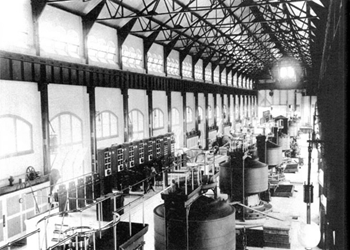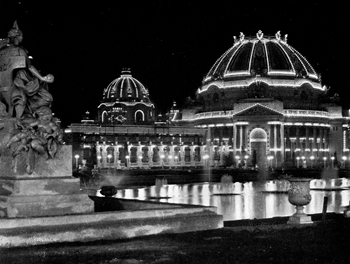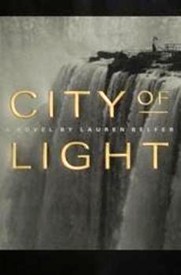 |
 |
| A virtual coffeehouse for technological minds and ideas |
|
City Of Light
City of Light author, Lauren Belfer, blends fiction with the facts of a technological revolution and combines it with mysterious murder and romance in a way that has made it one of my favorite novels.
In 1901 the city of Buffalo, New York hosted the Pan American
Exposition which featured dazzling displays of electric light
that certainly had to inspire awe in its visitors. Beyond this
visual show was an equally significant development of the
mechanical benefits that electricity would offer in terms of
reducing manual labor and increasing industrial productivity.
Human standards of living would be raised, and all of this
promise was being celebrated with great enthusiasm. It was also
being noticed - and coveted - by the financial barons of that time
It’s always interesting to wonder what seed a story started from. Did you choose the emerging power industry as a backdrop for your story or did your interest for a story begin with it? I grew up in Buffalo in the 1960s and 1970s, during an era of economic depression. All my friends and I could talk about was when, and how, we were going to leave the Niagara Frontier. Apart from our families and friends, we didn’t find anything to value in the city or in its history, nor had we been educated about the city’s extraordinary history. Years later, when I happened to be in Buffalo to visit my parents, I wandered into an exhibit at the Buffalo Historical Society. This exhibit was about the city’s glory days in 1901, and it included photographs and other materials relating to the development of hydroelectric power at Niagara Falls. The exhibit hit me with the force of a revelation – I’d never known about Buffalo’s position of prominence at the turn of the last century, or about the astonishing technological advances made at nearby Niagara Falls. That very day, I decided to write a novel about my much-maligned hometown during its brief and remarkable period of national preeminence. The city’s unique position as a recipient of Niagara’s electrical power was crucial to the city’s prosperity in 1901. Thus from the beginning, when I first began to sketch out the plot for "City of Light," I created characters and incidents that involved the power industry, so that I could show how pivotal the industry was in Buffalo’s, and the nation’s, history. The main character of your story was a woman named Louisa Barrett. She was intelligent, and for the most part self-confident, but you also gave her a very vulnerable quality that constantly struggled inside against the dilemmas of a rapidly changing world. Do you imagine our current revolution of information technology causing similar struggles in the people involved in it? Yes, absolutely. As I wrote "City of Light," I was very aware of the comparison between the electrical revolution and the information-technology revolution of our own time. When I write fiction, one of my goals is to portray the effect of changing technology on individual lives. Louisa Barrett is taken aback when she first enters a home which has been electrified. The light has a clarity that she never imagined possible. Soon after, she learns about the new industries being developed at Niagara Falls, industries that are feasible only because of cheap and readily available electricity. As a thinking person, she rightly ponders the benefits as well as the environmental repercussions of these new industries. Nowadays, young people like my teenage son take computer technology for granted, but this is far from the case for older people like, for example, my mom, who after some months of confusion and hesitancy, now uses the internet every day, communicating with friends around the world and researching myriad questions that come up in the course of a day. I also became interested in another element of technological revolution, one which is little recognized: When America was initially electrified, nothing was standardized – for example, a socket or a bulb that worked in one part of New York City might not work ten blocks away. This reminded me of the early days of the computer revolution, when multiple companies were competing with idiosyncratic hardware and software. Nowadays, with the computer industry fairly standardized around Microsoft PCs and Apple Macs (and these two becoming increasingly compatible), it’s hard to remember the "old days" when floppy disks were large and floppy and computers from different manufacturers operated in quite different ways. Similarly, it’s hard to remember that the electrical industry, too, evolved from the idiosyncratic to the standardized, and that the standardization, probably as much as any other factor, allowed for the mass-electrification of the nation. I remember years ago that many computer and internet users protested the dominance of Microsoft especially in the computer industry, but I wonder to what extent the standardization has allowed the technology to integrate itself into our lives in such a compelling way. All too quickly, technological advances turn into the reliable background of our lives, and I have to think that standardization encourages this process. I’m still amazed when I see my son video-chatting with his friends on his Apple Mac -- but of course to him, this ability is very much business-as-usual, nothing special. Although it’s a novel there are many historically accurate details in it that show a tremendous amount of research effort. Where did you start looking and where did you find the best answers? As I said earlier, I had the idea for the novel while I was visiting my parents in Buffalo. When I returned home to New York, I wondered how I would be able to begin my research while living far away from Buffalo. I immediately learned, however, that I had no reason to be concerned: the libraries in New York are filled with information about Buffalo and Niagara Falls, and particularly about the development of hydropower at Niagara Falls. The easy availability of research materials brought an important realization: Buffalo and Niagara were so important a hundred years ago that of course New York City libraries came to be filled with information. The electrical breakthroughs at Niagara were being funded by financiers based in New York City, and thousands of people were traveling to Buffalo for the Pan American Exposition. The Niagara Frontier truly was among the most important places in America, and people everywhere, in America and around the world, wanted to know about it. The Niagara Frontier had become the Silicon Valley of its day. The novel took six years to research and write, and during that time I returned to Buffalo for several research trips. In Buffalo, I was able to visit the sites that I was writing about, and this provided an extra measure of verisimilitude. Although many of the places had changed considerably over the years, I was still able to use my imagination to figure out what they must have been like during the time that my characters knew them. The people of Buffalo are unusually open and friendly, and more than once I simply knocked on the door of an old house, explained my research, and found myself welcomed and given a tour as if I were a family friend. As you became involved in the research process did it reveal any elements that gave validity to Mark Twain’s quote; "Truth is stranger than fiction…"? I would approach the issue of truth vs. fiction from a different standpoint: As I did my research, I was surprised over and over by the fact that crucial social and political issues of our day were also important in 1901: women’s rights, the rights of minorities, environmental protection, the personal morality of politicians – all these issues were debated in 1901, much as they are debated today. I found myself in an extremely familiar world, a world in which I felt comfortable and which I felt I understood. The early part of the story involves the 1901 Pan-American Exposition. It wasn’t the first public display of electric lighting, but it certainly was spectacular and historically significant to the electrification of the United States and the world. What did you imagine went through the minds of the thousands of visitors when they first saw the lighting displays at nighttime? Visitors came to the Pan-American Exposition literally from all over the world, and I believe the Pan-Am’s electrical display filled them with awe. Indeed, the Pan-Am’s lighting display was beyond both expectation and imagining for the visitors of 1901. They must have taken this feeling of awe away with them, and yearned to bring the miracle of electricity to their hometowns. The "cathedral of power" described in your story was a hydroelectric plant at Niagara Falls. Most people today take electric power for granted and think of hydroelectric generation as very benign, if not environmentally friendly. In your story, however, it becomes a very contentious issue between industrialists and preservationists who fight over the legal and ethical problems of using such a grand natural resource. Did this have a historical basis from your research or did you create it to add additional dimension to the story? The fight to save Niagara Falls was the first environmental battle in America. The industrialists were quite capable of shutting off the Falls by diverting all the water to power generation – and they would have, if not for the protests that finally spurred government intervention. The battle for Niagara Falls was fought in large part, surprisingly, in the pages of the magazine "The Lady’s Home Journal," whose editor championed the preservation cause. The fight was non-violent, however. I added the element of violence to heighten the drama and to reveal all that was at stake for the future of the nation. The power station in your story was based on the actual Adam’s Power Station, built in 1895 from designs by Nicola Tesla, a very famous inventor. Is his character hidden in the story somewhere? As far as I could learn, Tesla was not in Buffalo in 1901, and I didn’t include him in the story. By all accounts, he was quite an extravagant figure, brilliant and highly eccentric. Portraying him in fiction would have been fun, but I simply couldn’t find an opening for him. Electrical power seems so fundamental to our lifestyles that it’s hard to imagine it not existing for lack of any individuals or events. Do you think the birth of this industry was brought by the industrialist’s force of will or by its own inevitability? I think the triumph of electricity was a combination of industry will and inevitability. Niagara Falls wasn’t the only site of electrical development in America, but it was the most dramatic, both in terms of technological development and sheer physical monumentality. From the time I began my research, I was fascinated by the fact that in Europe, electricity was considered a human right, like running water and sewage systems in a major city. In America, however, electricity has always been a commodity, developed and sold for profit, revealing the predominance of industrialists in American culture. Have you ever thought that you’d like to see your novel made into a movie someday? I would be thrilled for "City of Light" to become a movie! And of course I believe it would be a terrific movie.
|
 “The generators gleamed black in the sunlight that poured through the
long, arched windows of Thomas Sinclair’s cathedral of power.”
“The generators gleamed black in the sunlight that poured through the
long, arched windows of Thomas Sinclair’s cathedral of power.”
 who could clearly see the wealth and power it could bring them,
and would let little stand in their way. These ingredients were
masterfully used by the author, who graciously agreed to answer
some of my questions that have been lingering since reading the
novel.
who could clearly see the wealth and power it could bring them,
and would let little stand in their way. These ingredients were
masterfully used by the author, who graciously agreed to answer
some of my questions that have been lingering since reading the
novel.
